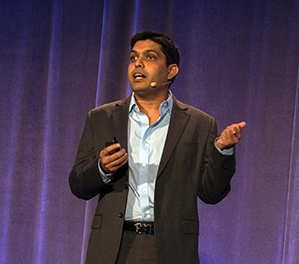Digital Summit: Microsoft Aims for Smartphones That Run for a Week
Charging your smartphone once a day—or more—is one of the rhythms of modern life. A new project at Microsoft aims to change that, by using software and hardware tricks to extend a device’s battery life to a week.

While mobile devices have become much more powerful since the first smartphones appeared, their battery life has barely improved, Microsoft researcher Ranveer Chandra said Monday at MIT Technology Review’s Digital Summit in San Francisco. That’s because battery chemistry has not followed the exponential pace of improvements in computing hardware. The density at which batteries can store energy has only doubled over the past 15 years, says Chandra, who leads the Microsoft project.
Microsoft’s effort is focused on tweaking the software or design of mobile devices so they use available battery life more efficiently. It’s an approach that has been largely overlooked in the past but can offer major improvements, said Chandra. “You can’t just wait for the best battery technology to come along,” he says. “We can make a lot of progress because systems today don’t use battery intelligently.”
The most radical idea Chandra’s team is testing is to give devices two smaller lithium-ion batteries instead of one large one. One would be optimized to efficiently provide a large supply of current, for example when a person is playing games on a phone. The other would be designed to trickle out smaller currents, such as when a phone is idle. Chandra and colleagues have built simple prototypes that could improve battery life 20 to 50 percent, he said.
Batteries don’t convert their stored energy into current with perfect efficiency. Some energy is always lost to heat and other processes when a battery supplies a current, and that waste increases dramatically when a battery is asked to supply a level of current it isn’t designed for. Today’s devices have batteries optimized for an average load, meaning that they waste significant energy in the peaks and troughs of a device’s usage.
Microsoft’s battery effort is still a research project, but ideas stemming from it have already filtered into products. Windows 8’s Wi-Fi software uses energy-saving techniques devised by the group, for example. Chandra’s work has also led to a tool for software developers that predicts how much energy a given app will use on a device and makes it easier to reduce the load.
Another idea for how software could stretch battery lives is taking shape in a research prototype. Known as E-Loupe, it allows a mobile operating system to identify and police apps that consume a lot of power even when a person is not actively using them. It can pause or slow the activity of a background process—for example, an app downloading a large file—to maximize battery life, says Chandra.
Wearable devices and electric cars could also benefit from software that is able to understand and adapt battery use, says Chandra. For example, a car might use its battery differently if a person asked the GPS for directions that involved a steep climb or plowing through slow-moving traffic.
Keep Reading
Most Popular
Large language models can do jaw-dropping things. But nobody knows exactly why.
And that's a problem. Figuring it out is one of the biggest scientific puzzles of our time and a crucial step towards controlling more powerful future models.
The problem with plug-in hybrids? Their drivers.
Plug-in hybrids are often sold as a transition to EVs, but new data from Europe shows we’re still underestimating the emissions they produce.
Google DeepMind’s new generative model makes Super Mario–like games from scratch
Genie learns how to control games by watching hours and hours of video. It could help train next-gen robots too.
How scientists traced a mysterious covid case back to six toilets
When wastewater surveillance turns into a hunt for a single infected individual, the ethics get tricky.
Stay connected
Get the latest updates from
MIT Technology Review
Discover special offers, top stories, upcoming events, and more.